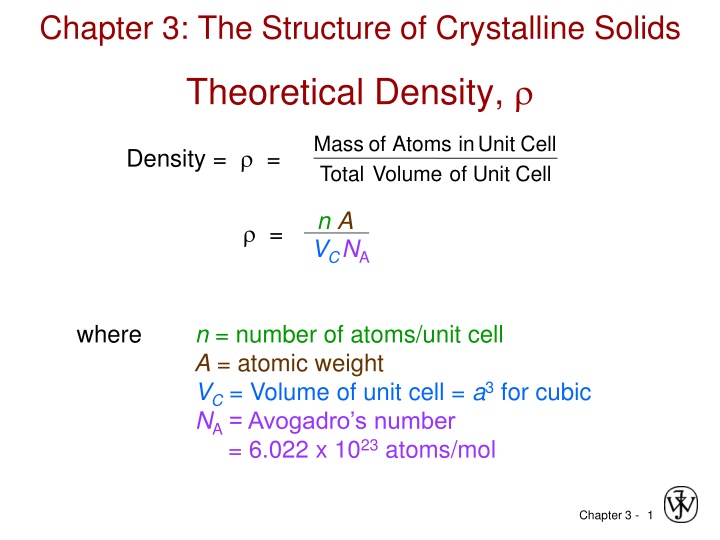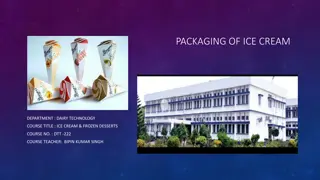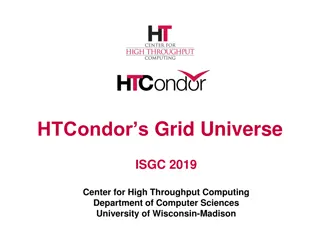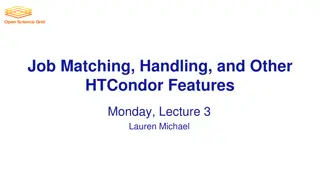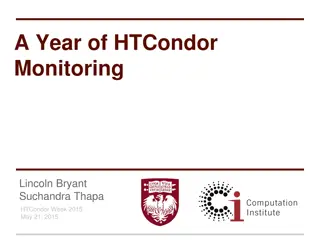Containers and HTCondor Center for High Throughput Computing
The benefits of utilizing containers in the HTCondor environment, including the importance of job containment and resource protection. Learn about the ideal container characteristics, job resources, HTCondor's containment methods, and techniques such as MOUNT_UNDER_SCRATCH and Control Groups. Discover how Cgroups help in limiting resources and controlling processes effectively.
Download Presentation

Please find below an Image/Link to download the presentation.
The content on the website is provided AS IS for your information and personal use only. It may not be sold, licensed, or shared on other websites without obtaining consent from the author.If you encounter any issues during the download, it is possible that the publisher has removed the file from their server.
You are allowed to download the files provided on this website for personal or commercial use, subject to the condition that they are used lawfully. All files are the property of their respective owners.
The content on the website is provided AS IS for your information and personal use only. It may not be sold, licensed, or shared on other websites without obtaining consent from the author.
E N D
Presentation Transcript
Chapter 3: The Structure of Crystalline Solids Theoretical Density, Mass of Atoms in Unit Cell Density = = Total Volume of Unit Cell nA = VCNA where n = number of atoms/unit cell A = atomic weight VC = Volume of unit cell = a3 for cubic NA= Avogadro s number = 6.022 x 1023 atoms/mol Chapter 3 - 1
Theoretical Density, Ex: Cr (BCC) A = 52.00 g/mol R = 0.125 nm n = 2 atoms/unit cell R a = 4R/ 3 = 0.2887 nm a Adapted from Fig. 3.2(a), Callister & Rethwisch 8e. atoms unit cell g 2 52.00 theoretical actual atoms mol = 7.18 g/cm3 mol = = 7.19 g/cm3 a3 6.022x1023 volume unit cell Chapter 3 - 2
Densities of Material Classes In general Graphite/ Ceramics/ Semicond Metals/ Alloys Composites/ fibers metals > ceramics > polymers Why? Metals have... close-packing (metallic bonding) often large atomic masses Ceramics have... less dense packing often lighter elements Polymers have... low packing density (often amorphous) lighter elements (C,H,O) Composites have... intermediate values Polymers 30 Based on data in Table B1, Callister *GFRE, CFRE, & AFRE are Glass, Carbon, & Aramid Fiber-Reinforced Epoxy composites (values based on 60% volume fraction of aligned fibers in an epoxy matrix). Platinum 20 Gold, W Tantalum 10 Silver, Mo Cu,Ni Steels Tin, Zinc Zirconia 5 (g/cm ) 3 Titanium 4 Al oxide Diamond Si nitride 3 Aluminum Glass-soda Concrete Glass fibers PTFE Silicon GFRE* Carbon fibers 2 Magnesium Graphite CFRE* Aramid fibers Silicone PVC AFRE* PET PC 1 HDPE, PS PP, LDPE 0.5 Wood 0.4 0.3 Data from Table B.1, Callister & Rethwisch, 8e. Chapter 3 - 3
Crystals as Building Blocks Some engineering applications require single crystals: -- diamond single crystals for abrasives -- turbine blades Fig. 8.33(c), Callister & Rethwisch 8e. (Fig. 8.33(c) courtesy of Pratt and Whitney). (Courtesy Martin Deakins, GE Superabrasives, Worthington, OH. Used with permission.) Properties of crystalline materials often related to crystal structure. -- Ex: Quartz fractures more easily along some crystal planes than others. (Courtesy P.M. Anderson) Chapter 3 - 4
Polycrystals Anisotropic Most engineering materials are polycrystals. Adapted from Fig. K, color inset pages of Callister 5e. (Fig. K is courtesy of Paul E. Danielson, Teledyne Wah Chang Albany) 1 mm Isotropic Nb-Hf-W plate with an electron beam weld. Each "grain" is a single crystal. If grains are randomly oriented, overall component properties are not directional. Grain sizes typically range from 1 nm to 2 cm (i.e., from a few to millions of atomic layers). Chapter 3 - 5
Single vs Polycrystals Single Crystals -Properties vary with direction: anisotropic. -Example: the modulus of elasticity (E) in BCC iron: E (diagonal) = 273 GPa Data from Table 3.3, Callister & Rethwisch 8e. (Source of data is R.W. Hertzberg, Deformation and Fracture Mechanics of Engineering Materials, 3rd ed., John Wiley and Sons, 1989.) E (edge) = 125 GPa Polycrystals -Properties may/may not vary with direction. -If grains are randomly oriented: isotropic. (Epoly iron = 210 GPa) -If grains are textured, anisotropic. 200 m Adapted from Fig. 4.14(b), Callister & Rethwisch 8e. (Fig. 4.14(b) is courtesy of L.C. Smith and C. Brady, the National Bureau of Standards, Washington, DC [now the National Institute of Standards and Technology, Gaithersburg, MD].) Chapter 3 - 6
Polymorphism Two or more distinct crystal structures for the same material. Allotropy-when found in elemental solids. iron system titanium , -Ti liquid 1538 C -Fe BCC carbon diamond, graphite 1394 C -Fe FCC Allotropy of iron 912 C -Fe BCC Chapter 3 - 7
Tin (Its Allotropic Transformation) White (or beta) tin, having a body-centered tetragonal crystal structure at room temperature, transforms, at 13.2 C (55.8 F), to gray (or alpha) tin, which has a crystal structure similar to diamond. The rate at which this change takes place is extremely slow; however, the lower the temperature (below 13.2 C) the faster the rate. This transformation results in: Increase in volume (27 %), and, a decrease in density (from 7.30 g/cm3 to 5.77 g/cm3). Consequently, this volume expansion results in the disintegration of the white tin metal into a coarse powder of the gray allotrope. This produced some rather dramatic results in 1850 in Russia. The winter that year was particularly cold, and record low temperatures persisted for extended periods of time. The uniforms of some Russian soldiers had tin buttons, many of which crumbled because of these extreme cold conditions, as did also many of the tin church organ pipes. This problem came to be known as the tin disease. Chapter 3 - 8
3.7 Iron has a BCC crystal structure, an atomic radius of 0.124 nm, and an atomic weight of 55.85 g/mol. Compute and compare its theoretical density with the experimental value found inside the front cover. 3.8 Calculate the radius of an iridium atom, given that Ir has an FCC crystal structure, a density of 22.4 g/cm3, and an atomic weight of 192.2 g/mol. Chapter 3 - 9
